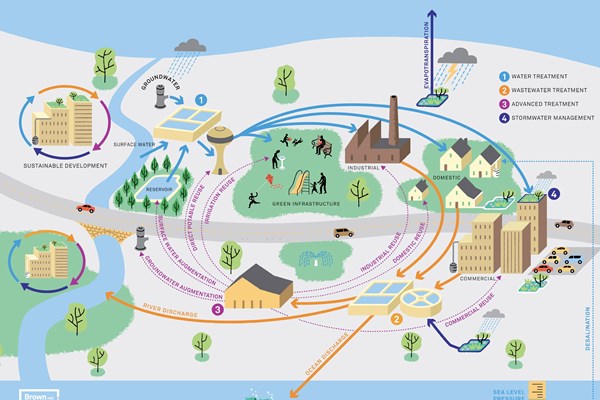‘One Water’ approaches gain traction across the Hawaiian Islands
Nov 25, 2024

Last month’s 2024 Hawai‘i Water Works Association Conference on Kaua‘i featured an insightful panel discussion on the growing ‘One Water’ movement and how it can benefit communities across the state. Moderated by Christin Reynolds of One World One Water, the panel brought together water experts from various counties to share their experiences and perspectives.
Unlike traditional siloed methods, the ‘One Water’ movement emphasizes an integrated, holistic view of the entire water cycle, focusing on integrating the management of water, wastewater, and stormwater, delivering benefits to both the community and local ecosystems.
Jeremy Kimura, Ulupono Initiative’s director, fresh water sector, kicked off the discussion by reflecting on the parallels between the One Water framework and the state's existing water planning efforts. “When you look at the One Water graphic, it really reminds me of the Hawai‘i Water Plan and what it’s intended to do,” Kimura said. However, he emphasized that constant engagement and dedicated coordination are needed to make it work.
Kimura pointed out that water agencies often have a narrow mission focused solely on delivering safe, reliable drinking water. “The county water department has just a tiny slice of what’s happening,” he explained. “There needs to be that space within the county for somebody to engage on a constant level with all the agencies and to really see these One Water initiatives go forward.”
Drawing on his past experience working at the State of Hawai‘i Commission on Water Resource Management, Kimura suggested that creating a dedicated entity, similar to the One Water panel on O‘ahu, could provide the necessary safe space for cross-agency collaboration and community engagement. “That’s where the change really moves,” he said, “when you have us who have the technical knowledge working together with an empowered community to build the political will.”
John Stufflebean, director of the Maui County Department of Water Supply, echoed the importance of expanding mission statements to embrace the principles of One Water. He shared how his department has evolved from only focusing on providing water “as cheaply as possible” to a more holistic approach that considers community benefits and environmental stewardship.
Maui’s efforts include a 4% budget allocation for watershed protection, an 8% reduction in water use through conservation measures, and the exploration of recycled water and a “greenway” project to enhance fire resilience in the Lahaina area. Stufflebean emphasized that these initiatives have been catalyzed by the relationships and collaboration forged in the wake of the devastating West Maui fires.
Keith Okamoto, manager-chief engineer at the Hawai‘i County Department of Water Supply, acknowledged the resource constraints faced by water agencies but urged the audience to leverage their spheres of influence. “Share the good word about how the water, our freshwater resource, is precious — it is limited,” he said. “If there’s some information that comes your way regarding this One Water mindset, please take the opportunity to share that.”
The panel’s insights underscored the growing momentum behind One Water approaches in Hawai‘i, with each county finding unique ways to integrate this holistic framework into their water management strategies. As the discussion highlighted, the key lies in fostering cross-agency collaboration, empowering communities, and expanding the mission of water organizations to truly unlock the transformative potential of One Water for a more sustainable and resilient future.
The One Water framework offers a distinct and valuable approach to Hawai‘i’s water management challenges. Crucially, it requires robust cross-agency collaboration and governance structures — a critical need in Hawai‘i, where water management responsibilities are often spread across different county departments. By aligning with the state’s existing water planning efforts and empowering community engagement, the One Water framework provides a relevant and transformative pathway for Hawai‘i to address pressing our complex water challenges.
Here are some additional anecdotes that were shared during the session:
Honolulu’s Pioneering Approach:
The panel discussed how Honolulu took a unique approach to institutionalizing collaboration on One Water initiatives. Rather than waiting to identify specific projects to work on, the city made an ordinance requiring all relevant agencies to come together and address climate change and sea level rise. This proactive step to formalize cross-agency coordination was recognized nationally as a model for other communities.
Maui’s Watershed Protection Efforts:
John Stufflebean shared that Maui County has been dedicating 4% of its entire budget to watershed protection for many years. He described this as “maybe the most important thing we do” to secure the island's water sources, even though the long-term impacts may not be immediately visible.
Smart Meter Challenges in Maui:
When discussing Maui’s water conservation initiatives, Stufflebean acknowledged the county's challenges in deploying smart water meters. Due to cellular coverage issues in some areas, the smart meter program has been “a little bumpy,” requiring the county to explore alternative approaches like drive-by meter readings. He offered this as a lesson learned for other utilities considering smart meter implementations.
The Impact of the West Maui Fires:
Stufflebean highlighted how the devastating West Maui fires served as a catalyst for increased collaboration and relationship-building among various county departments and agencies. He noted that “the best way to build a relationship is to do something important together and to work together,” and the fire response efforts helped forge these crucial connections.
Expanding Missions and Mindsets:
Both Stufflebean and Okamoto emphasized the need for water agencies to expand their mission statements and mindsets beyond providing water “as cheaply as possible.” They stressed the importance of incorporating community benefits, environmental stewardship, and a holistic view of the water cycle into the core purpose of these organizations.

